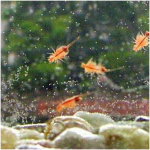More scientific (less woo-ish) explanation for the stuck magnets - the hydrogel used in the mRNA vaccines:
Article is too long to copy over in full,
go to link for full article and graphics:
Tissue engineering is a promising strategy for the repair and regeneration of damaged tissues or organs. Biomaterials are one of the most important components in tissue engineering. Recently, magnetic hydrogels, which are fabricated using iron ...

www.ncbi.nlm.nih.gov
(fair use applies)
EXCERPT
Recent Advances on Magnetic Sensitive Hydrogels in Tissue Engineering
Zhongyang Liu,1,2,†
Jianheng Liu,1,2,†
Xiang Cui,1,2,†
Xing Wang,3,*
Licheng Zhang,1,2,* and
Peifu Tang1,2,*
Published online 2020 Mar 6.
Abstract
Tissue engineering is a promising strategy for the repair and regeneration of damaged tissues or organs. Biomaterials are one of the most important components in tissue engineering. Recently,
magnetic hydrogels, which are fabricated using iron oxide-based particles and different types of hydrogel matrices, are becoming more and more attractive in biomedical applications by taking advantage of their biocompatibility, controlled architectures, and smart response to magnetic field remotely. In this literature review, the aim is to summarize the current development of magnetically sensitive smart hydrogels in tissue engineering, which is of great importance but has not yet been comprehensively viewed.
Introduction
Tissue engineering, a branch of regenerative medicine, refers to the application of supporting cells, material scaffolds, bioactive molecules, or their combinations to repair and reconstruct tissues and organs. Hydrogels have been shown to be one of the most applicable biomaterials in tissue engineering (Kabu et al.,
2015; Madl et al.,
2017,
2019; Deng et al.,
2019) mainly attributed to their inner 3D network microstructures, moderate biocompatibility, and good water content feature, which are analogous with those of the natural tissue (Cui Z.K. et al.,
2019; Zhu et al.,
2019). Meanwhile, hydrogel-based drug delivery systems for numerous therapeutic agents, with high water content, low interfacial tension with biological fluids, and soft consistency, have been shown to be more stable, economical, and efficient in comparison with conventional delivery systems (Li and Mooney,
2016; Moore and Hartgerink,
2017; Cheng et al.,
2019; Fan et al.,
2019; Zheng et al.,
2019). Considering the above advantages, hydrogels have been conducted into the biomedical application to provide a tunable three-dimensional scaffold for cell adhesion, migration, and/or differentiation, and they could also be designed as the platform for the controlled release of cytokines and drugs in tissue engineering and drug delivery (Huang et al.,
2017; Jiang et al.,
2017; Hsu et al.,
2019; Wei et al.,
2019; Zheng et al.,
2019).
Hydrogel first appeared in a literature as early as in 1894 (Van Bemmelen,
1894); however, the “hydrogel” described at that time was not the same form of hydrogels used nowadays; it was a type of a colloidal gel made from inorganic salts. Later on, the term “hydrogel” was applied for describing a 3D network of hydrophilic native polymers and gums by physical or chemical crosslinking approaches, and its application heavily relied on water availability in the environment (Lee et al.,
2013). The current generation of hydrogel in the biological field was first performed by Wichterle and LÍm (
1960), indicating that glycoldimethacrylate-based hydrophilic gels exhibited adjustable mechanical properties and water content. From then on, more and more hydrogels have been developed, and the smart hydrogels were then introduced in different fields of biological science, such as drug delivery, bioseparation, biosensor, and tissue engineering. Smart hydrogels are described as they respond directly to the changes of environmental conditions (Wichterle and LÍm,
1960), and numerous studies of smart hydrogels in the applications of nanotechnology, drug delivery, and tissue engineering have been put into effect in the last few decades (Li X. et al.,
2019; Li Z. et al.,
2019; Zhang Y. et al.,
2019).
Recently, magnetically responsive hydrogel, as one kind of smart hydrogels, has been introduced into biomedical applications in improving the biological activities of cells, tissues, or organs.
This is mainly attributed to its magnetic responsiveness to external magnetic field and obtaining functional structures to remotely regulate physical, biochemical, and mechanical properties of the milieu surrounding the cells, tissues, or organs (Abdeen et al.,
2016; Antman-Passig and Shefi,
2016; Rodkate and Rutnakornpituk,
2016; Bannerman et al.,
2017; Omidinia-Anarkoli et al.,
2017; Xie et al.,
2017; Silva et al.,
2018; Tay et al.,
2018; Wang et al.,
2018; Bowser and Moore,
2019; Ceylan et al.,
2019; Luo et al.,
2019). Recent studies have represented that magnetic hydrogel could act as an excellent drug release and targeting system. For example, Gao et al. (
2019) fabricated a magnetic hydrogel based on ferromagnetic vortex-domain iron oxide and suggested that this unique magnetic hydrogel could significantly suppress the local breast tumor recurrences. Manjua et al. (
2019) developed magnetic responsive poly(vinyl alcohol) (PVA) hydrogels, which could be motivated by ON/OFF magnetic field and non-invasively regulated protein sorption and motility, indicating a promising application for tissue engineering, drug delivery, or biosensor system. Moreover, a composite magnetic hydrogel prepared by a combination of a self-healing chitosan/alginate hydrogel and magnetic gelatin microspheres could be used as a suitable platform for tissue engineering and drug delivery (Chen X. et al.,
2019a). In comparison with magnetic hydrogels, various kinds of smart biomaterials (e.g., scaffolds, biofilms, other smart hydrogels), which are activated by external stimuli, such as light, pH, temperature, stress, or charge, have great potential in biomedical applications (Chen H. et al.,
2019; Cui L. et al.,
2019; Wu C. et al.,
2019; Zhao et al.,
2019; Yang et al.,
2020). However, the long response time and less precisely controlled architectures of these stimuli-responsive smart biomaterials are the two main limitations.
Magnetic hydrogels are usually made of a matrix hydrogel and a magnetic component that was incorporated into the matrix. Recently, superparamagnetic and biocompatible iron oxide-based
magnetic nanoparticles (MNPs) are most commonly incorporated into polymer matrices to prepare magnetically responsive hydrogels for their application in tissue engineering, such as γ-Fe2O3, Fe3O4, and cobalt ferrite nanoparticles (CoFe2O4) (Zhang and Song,
2016; Rose et al.,
2017; Ceylan et al.,
2019). Magnetite (Fe3O4) is a compound of two kinds of iron sites with 1/3 of Fe2+ and 2/3 of Fe3+. The intervalence charge transfer between Fe2+ and Fe3+ induces absorption throughout the ultraviolet–visible spectral region and the infrared spectral region, which generates a black appearance in color (Barrow et al.,
2017). Maghemite (γ-Fe2O3), with a brown-orange color pattern, is an oxidative product of magnetite (Fe3O4) when the temperature is below 200°C (Tang et al.,
2003). In terms of CoFe2O4, previous studies have shown that the concentration of 20% was toxic, whereas at 10% the toxicity was insignificant. Moreover, 10% (w/w) of CoFe2O4 could maximize magnetic response because of numerous amounts of nanoparticles, developing biocompatible biomaterials (Goncalves et al.,
2015; Brito-Pereira et al.,
2018). For example, Hermenegildo et al. (
2019) designed a novel CoFe2O4/Methacrylated Gellan Gum/poly(vinylidene fluoride) hydrogel, which created a promising microenvironment for tissue stimulation.
In this literature review, we aim to summarize the preparation methods and current development of magnetically sensitive smart hydrogels in tissue engineering, especially in bone, cartilage, and neural tissue engineering, which are of great importance but have not yet been comprehensively reviewed.
[....] [SNIPPED OUT THE MIDDLE OF THE ARTICLE AND JUMPED TO THE END]
Applications in Other Organs
Besides the bone, cartilage, and nerve organs, magnetic hydrogels are also introduced into other organs, such as the heart, skin, and muscle, in order to evaluate the therapeutic potential. Namdari and Eatemadi (
2017) designed a magnetic hydrogel by dissolving Fe3O4 and curcumin into the N-isopropylacrylamide-methacrylic acid (NIPAAM-MAA) hydrogel. The resulting magnetic hydrogel nanocomposite was able to reduce the doxorubicin-induced cardiac toxicity and hold the cardioprotective capability. Cezar et al. (
2016) fabricated a ferrogel scaffold by using RGD peptides modified alginate and iron oxide. The magnetic ferrogel showed fatigue resistance and in combination with magnetic stimulation (6,510 Gauss, 5 min at 1 Hz every 12 h) could mechanically activate and promote severely injured muscle tissue regeneration. Rose et al. (
2018) developed a magnetic hybrid hydrogel by blending the MNPs into the Gly-Arg-Gly-Asp-Ser-Pro-Cys (GRGDSPC) modified six-arm-PEG gel for fibroblast alignment, which is crucial for the wound healing.
Injectable Magnetic Hydrogel's Application in Tissue Engineering
Recently, the
magnetic hydrogels as injectable systems have displayed great potential for tissue repair and magnetic drug targeting. Various kinds of cells and molecules can be encapsulated homogeneously into the magnetic hydrogels and then targeted to the pathological sites with minimal invasiveness (Wu et al.,
2018; Chen X. et al.,
2019b; Shi et al.,
2019; Wu H. et al.,
2019; Xu et al.,
2019). Several polymers, including ionic-response polymers (e.g., sodium alginate), natural biocompatible polymers (e.g., chitosan), and synthetic polymers (e.g., polyacrylic acid), conjugated with the magnetic particles have been used to fabricate the injectable hydrogels for therapeutic applications (Jalili et al.,
2017; Hu et al.,
2018; Amini-Fazl et al.,
2019). These magnetic hydrogels could be guided to the diseased sites via external magnetic fields and exert a drug release influence there. Meanwhile, this kind of magnetic hydrogel is mainly targeted for the cancer therapy due to the hyperthermia effect under the applied magnetic field.
The Metabolism of Magnetic Particles From the Magnetic Biomaterials
Although numerous studies have shown that magnetic biomaterials exhibited biocompatibility both
in vitro and
in vivo, the cytotoxicity and long-term fate of magnetic particles embedded within the magnetic hydrogels
in vivo must be taken for consideration. No identical criteria have been made to evaluate this important issue of magnetic hydrogels since the fabrication process and physicochemical properties vary in many aspects. The Food and Drug Administration (FDA) in the United States had approved several MNPs in the clinical applications, such as the treatment of anemia caused by chronic kidney disease and the magnetic resonance imaging, and these MNPs could be removed quickly by the liver (Laconte et al.,
2005; Ventola,
2017). The clearance of magnetic particles
in vivo depends on the size of the particle. In detail, particles smaller than 5.5 nm could be removed quickly through the kidney (Sun et al.,
2008), particles up to 200 nm could be sequestered by phagocytes of the spleen (Chen and Weiss,
1973), and particles larger than 5 μm could be cleared via the lymphatic system (Arruebo et al.,
2007). In addition, magnetic fields have proven to control the anisotropic feature, constitution, and the degradation rate in the magnetic hydrogels (Huang J. et al.,
2018; Silva et al.,
2018). All these factors are crucial for the released amounts of magnetic particles from the magnetic constructs and the impact on organs. More efforts are needed to develop more controllable magnetic hydrogels for
in vivo applications.
Conclusions and Perspectives
The magnetically responsive smart hydrogels have emerged as an immensely potential biomaterial for developing bioaligned actuators. Benefiting from their intriguing features, including but not limited to quick response, mimetic native tissues, appealing mechanical properties, and biocompatibility, magnetic hydrogels have undergone unparalleled advances in biomedical fields, such as bone, cartilage, nerve, heart, muscle tissue engineering, and so on. However, the properties of magnetic particles, such as size, shape, composition, crystallinity, and so on, should be further modified in order to avoid overheating when cell-laden hydrogels are assembled. Meanwhile, the hydrogel matrices used in magnetic hydrogels need to be further evaluated by mimicking the native architectures of tissues and organs, which holds great potential for the preclinical treatment. Therefore, combined strategies should be developed to create more and more smart hydrogels in tissue engineering (
Figure 8).
Future perspectives should focus on dealing with the existing difficulties. In addition, more attention should be taken into consideration in evaluating the magnetic hydrogels' pharmacokinetics/toxicokinetics, metabolism, biodegradation
in vivo, and so on, which are of great significance in the applications of tissue engineering.
PubMed Central Image Viewer.
[go to link for the middle part of the article I snipped out, it's many pages long with lots of graphics]







